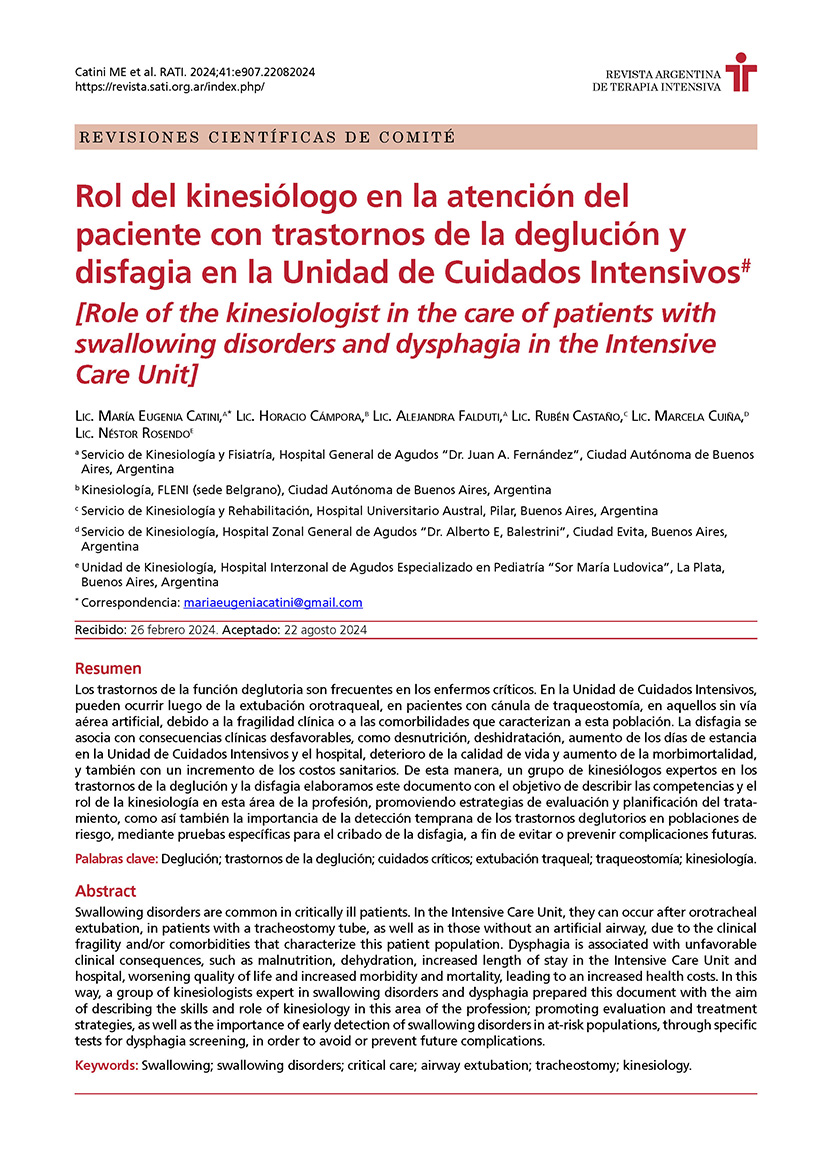Role of the kinesiologist in the care of patients with swallowing disorders and dysphagia in the Intensive Care Unit
Main Article Content
Abstract
Swallowing disorders are common in critically ill patients. In the Intensive Care Unit they can occur after orotracheal extubation, in patients with a tracheostomy tube, as well as in those without an artificial airway, due to the clinical fragility and/or comorbidities that characterize this patient population. Dysphagia is associated with unfavorable clinical consequences such as malnutrition, dehydration, increased length of stay in the intensive care unit and hospital, worsening quality of life and increased morbidity and mortality, leading to an increased health costs.
In this way, a group of kinesiologists experts in swallowing disorders and dysphagia prepared this document with the aim of describing the skills and role of kinesiology in this area of the profession; promoting evaluation and treatment strategies, as well as the importance of early detection of swallowing disorders in at-risk populations, through specific tests for dysphagia screening, in order to avoid or prevent future complications.
Article Details

This work is licensed under a Creative Commons Attribution 4.0 International License.
The magazine does not retain the reproduction rights (copyright) so the authors can republish their works with the sole mention of the original publication source.
References
Fernández Carmona A, Peñas-Maldonado L, Yuste-Osorio E, Diaz-Redondo A. Exploración y abordaje de disfagia secundaria a la vía aérea artificial. Medicina Intensiva. 2012;36(6):423-433
Cámpora H, Falduti A. Deglución de la A a la Z. Fisiopatología, evaluación, tratamiento. Ediciones Journal. Segunda edición. 2019.
Rebollo Pérez, MI, Rabat Restrepo JM, Diaz Borrego P et al. Abordaje integral del paciente con disfagia orofaríngea. Consenso de expertos GEDYN. Terapia médica nutricional y tratamiento rehabilitador. Nutr Clin Med. 2023. Doi: 10.7400/NCM.2023.17.1.5118.
Cámpora H, Falduti A. Planificación de la rehabilitación de la vía aérea superior y la función de la deglución en el paciente con cánula de traqueostomía. RAMR.2020; 2:171-180
Brodsky MB, Nollet JL, Spronk PE, Gonzalez-Fernandez M. Prevalence, pathophysiology, diagnostic modalities, and treatment options for dysphagia in critically ill patients. Am J Phys Med Rehabil 2020; 99:1164e70.
Pryor L, Ward E, Cornwell P, O’Connor S, Chapman M. Patterns of return to oral intake and decannulation post-tracheostomy across clinical populations in an acute inpatient setting. Int J Lang Commun Disord 2016;51(5):556-67.
Fredes S, Tiribelli N, Setten M. et al. Definición del rol y las competencias del kinesiólogo en la Unidad de Cuidados Intensivos. Revista Argentina de Terapia Intensiva. 2018. 35 N° 4.
McCarty, BE, Chao, TN. Dysphagia and Swallowing Disorders. The Medical clinics of North America. 2021;105(5):939-954. Doi: 10.1016/j.mcna.2021.05.013
Feng HY, Zhang PP, Wang XW. Presbyphagia: Dysphagia in the elderly. World J Clin Cases. 2023;16;11(11):2363-2373. Doi :10.12998/wjcc.v11.i11.2363
Zuercher P, Schenk NV, Moret C, Berger D, Abegglen R, Schefold JC. Risk factors for dysphagia in ICU patients after invasive mechanical ventilation. Chest. 2020; 158:1983e91.
McIntyre M, Doeltgen S, Dalton N, Koppa M, Chimunda T. Post-extubation dysphagia incidence in critically ill patients: A systematic review and meta-analysis.
Crit Care. 2021; 34(1):67-75
Lugaro MC, Risso-Vázquez A. Trastornos Deglutorios luego de la extubación en Terapia Intensiva. Revista Argentina de Terapia Intensiva. 2018; 35(3):43-54.
Zuercher P, Moret CS, Dziewas R, Schefold JC. Dysphagia in the intensive care unit: epidemiology, mechanisms, and clinical management. Crit Care.2019;23:103
Perren A, Zürcher P, Schefold JC. Clinical approach assessment post extubation dysphagia (PED) in the critically ill. Dysphagia. 2019;34(4):475-86
Suntrup-Krueger, S, Schmidt, S, Warnecke, T et al. Extubation Readiness in Critically Ill Stroke Patients. Stroke. 2019; 50(8):1981-1988. Doi: 10.1161/STROKEAHA.118.024643.
Battaglini, D, Siwicka Gieroba, D, Brunetti, I et al. Mechanical ventilation in neurocritical care setting: A clinical approach. Best Pract Res Clin Anaesthesiol. 2021; 35(2), 207–220. doi.org/10.1016/j.bpa.2020.09.001
Skoretz SA, Riopelle SJ, Wellman L, Dawson C. Investigating swallowing and tracheostomy following critical illness: a scoping review. Crit Care Med 2020;48: e141e51.
Falduti AK, Chiappero GR, Catini ME. Estudio de prevalencia de lesiones
laríngeas y disfagia en pacientes críticos traqueostomizados por COVID-19. Rev Am Med Resp 2022; 22:198-208. doi.org/10.56538/OSJZ9738
Burkhead LM, Sapienza, CM, Rosenbek, JC. Strength-Training Exercise in Dysphagia Rehabilitation: Principles, Procedures, and Directions for Future Research. Dysphagia.2007;22(3):251-65. Doi: 10.1007/s00455-006-9074-z.
Zhao T, Wu X, Zhang Q, Li C, Worthington HV, Hua F. Oral hygiene care for critically ill patients to prevent ventilator-associated pneumonia. Cochrane Database of Syst Rev 2020; Dec 24;12(12):CD008367. Doi: 10.1002/14651858.CD008367.
Catini ME, Falduti A. Maniobras deglutorias utilizadas en el tratamiento de la disfagia orofaríngea. AJRPT. 2020; (2):3. doi.org/10.58172/ajrpt.v2i3.135
Zaga CJ, Chao C, Cameron TA et al. Multidisciplinary Approach to Verbal Communication Interventions for Mechanically Ventilated Adults With a Tracheostomy. Respiratory Care. 2023;(68):5
Villalba, D, Lebus J, Quijano A, Bezzi M, Plotnicov G. Retirada de la cánula de traqueostomía. Revisión bibliográfica. Revista Argentina de Terapia Intensiva. 2014; (31) 1
Fernández-Carmona A, Olivencia-Pérez L, Yuste-Ossorio L, Peñas-Maldonado y grupo de trabajo de unidad de ventilación mecánica domiciliaria de Granada. Med Intensiva. 2018; (42) 1:50-59
Johnson DC, Campbell SL, Rabkin JD. Tracheostomy tube manometry: evaluation of speaking valves, capping and need for downsizing. Clin Respir J. 2009; 3 (1)8-14. Doi: 10.1111/j.1752-699X.2008.00100.x
Garuti G, Reverberi C, Briganti A, Massobrio M, Lombardi F, Lusuardi M. Swallowing disorders in tracheostomized patients: A multidisciplinary/multiprofessional approach in decannulation protocols. Multidiscip Respir Med. 2014; Jun 20;9(1):36. Doi: 10.1186/2049-6958-9-36.
www.idssi.org
Chiappero G, Falduti A, Cámpora H et al. Detección de la disfagia en el paciente adulto con vía aérea artificial en Terapia Intensiva. Revisión narrativa y recomendaciones de expertos intersocietarias. Revista Argentina de Terapia Intensiva. 2020;37(1): 20-35
Cámpora H, Costilla M, Estol C et al. Consenso de diagnóstico y tratamiento de los trastornos deglutorios y nutricionales de los pacientes con accidente cerebrovascular. Revista Argentina de Terapia Intensiva, 35(2S).
Catini ME, Falduti A, Chiappero G. Evaluación de la deglución en el paciente internado en Terapia Intensiva: una encuesta nacional. Revista Argentina de Terapia Intensiva. 2020;37(3):1-13
Chiappero G, Falduti A, Catini ME. traqueostomía y deglución en tiempos de pandemia. Revisión narrativa. Revista Argentina de Terapia Intensiva. 2021;38: e789.26072021

